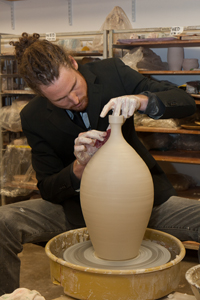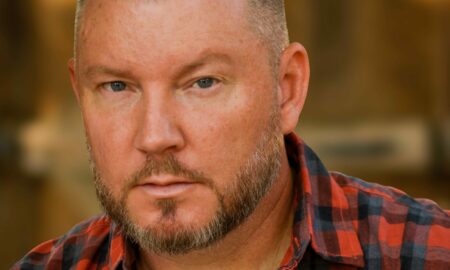 Today we’d like to introduce you to James Olney.
Today we’d like to introduce you to James Olney.
James, please share your story with us. How did you get to where you are today?
I’ve been an artist for as long as I can remember and always knew that is what I wanted to do. I was exposed to the creative process constantly growing up as my father was a preacher and passionate about theater. I was inspired by his intensity as I’d help him memorize a sermon for Sunday worship or for an upcoming theatrical performance.
I graduated from Southwestern University in Georgetown Texas with a degree in Studio Art with a focus in ceramics. I wanted to dive deep into the world of clay and immerse myself completely, so I decided an alternative path than most. I chose to do an apprenticeship instead of going to grad school. I did this for several reasons. First, I am terribly dyslexic so I knew I didn’t want to spend another moment in a classroom. Second, I wanted to learn the skill of pottery from the ground up the way people have been learning for thousands of years. I was lucky to land an apprenticeship with Master Potter Mark Hewitt in 2002. Mark Hewitt is an Englishman living and working in North Carolina. Mark offered a traditional apprenticeship which focuses on everything a working studio potter needs to know in order to set up successful pottery. I spent the next three years learning to mix clay the old fashioned way, learned to mix glazes from scratch, made tons of pots to my teacher’s strict specifications, to load and fire a traditional wood-fired groundhog kiln, and I learned how a small business is run. I essentially learned how to be efficient and professional as is required to be a successful potter.
When my apprenticeship ended in 2005, I was given the title Master Potter. This is a title that is given to students after they complete the required duties as an apprentice and are deemed by their Master teacher to be prepared. The title Master Potter goes back many generations and can only be given by a Master Potter to his or her student. The title is becoming less common today as students prefer to go to graduate school and receive a degree instead of a title. For me, it was the most obvious choice as I wanted real hands-on experience from a Master.
After my apprenticeship, I continued my education as is traditionally necessary and I became a Journeyman potter. A journeyman continues to work with other potters and artists so as to continue to expand skills in new ways. I moved to Minnesota and worked with potter and artist Bill Gossman. Bill encouraged me to look at my work in a broader and more artistic sense. He taught me to break free from what I know and enter into the world of the unknown. With him, my Pottery became more free and spontaneous.
In 2006, I joined the Peace Corps and moved to Tanzania in East Africa. It was here that I began working with village potters. The potters in the village of Tanzania were unlike any potters I had seen before. I worked with three Potters Vera, Usta, and Joyce. As is traditional, all the potters in Tanzania are women but they were happy to have my work alongside them. We dug and collected our clay by hand and all of the pots were made by coiling the clay without the aid of a potters wheel. I worked with these potters for two years learning that everything can be done literally from the ground up as potters have done for thousands of years with the help of only simple hand tools.
Moving back to the US in 2008, I moved to Rochester New York and worked at the Rochester Folk art Guild. I made mostly functional pots and sold them in galleries around New York. I was in New York only six months before I set off again to travel all over India and SE Asia. I visited artists and potters throughout rural India, Thailand, Lao and Vietnam gaining further understanding of how potters around the world see and use clay to make the highest quality pottery. I was struck by how authentic and true these potters were to tradition.
I moved back to Texas in 2010 and began teaching and making more pots. I decided to specialize in making designer industrial pots for high-end restaurants. I currently make pots for Tei Tei Robata sushi restaurant as well as Salary Man ramen restaurant in Oak Cliff. The design is unique to each restaurant so as to keep the pots fresh and unique. Most of the pots are wood-fired in a large kiln which takes four days to load and to fire. The process is challenging and laborious and often not every pot makes it out of the kiln successfully. The ash, smoke, flame, and heat perform a dance with the pots in the kiln creating organic colors and rich surfaces which is unique only to wood firing. The kiln takes about a week to cool before we can remove the pots. Each pot is then carefully cleaned off and polished so that any sharp places become smooth and functional. Although many of the pots are of a similar shape, depending on where the pot is placed in the kiln it might have a completely unique surface and color from its neighbor nearby. This richness in quality and unpredictability in a surface is what high-end Sushi and ramen restaurants like Tei Tei Robata and Salary Man prefer. The pots I make for these restaurants reflect a similar quality as those made in Korea and Japan and pair nicely with the color and palate presented to them by the finest chefs in Dallas Texas.
My journey as an artist and a potter is inspired by many traditions and cultures throughout the world. I am of the belief that great art and craft is pure communication. We learn from the traditions and cultures before us, we use this knowledge to make work which is unique to ourselves in the present, and if we are lucky, we become those who inspire those who follow us. Fine Art and craft is a natural flow of learning to see, learning to feel, and learning to create. It takes time. If we believe in it, as all cultures before us have, we will realize that fine art and craft aren’t simply random happenings which distract us from more important things in life. Fine art and Craft is what creates the culture and what makes us spiritual beings. It is the best and most real thing we have to offer the world.
Great, so let’s dig a little deeper into the story – has it been an easy path overall and if not, what were the challenges you’ve had to overcome?
I think learning to be a great and successful artist is rarely a smooth road for anyone. After college, I worked from 2002-2009 learning the craft and selling very few pots along the way. Not only do I make all my work myself, I am my own businessman doing everything myself. It can be time-consuming and frustrating at times. Being an artist is incredibly rewarding as it allows me to get at the heart of what I feel and believe the world should be about. Finding that support in what I do can often be a challenge in an ever-changing world, but it’s what I know and its what I love.
Alright – so let’s talk business. Tell us about Oak Cliff Pottery – what should we know?
Oak Cliff Potter is the name of my business. I mostly make designer industrial pottery for high-end restaurants like Tei Tei Robata and Salary Man here in Dallas. I also make a variety of things for other businesses like wine cups and cheese keepers for a business called Cheese and Chutney and I make flower vases and planters for florist shops including Sage Blooms and House of Dirt. I also sell my work at the Good Local Farmers Market near Whiterock lake to customers who are enthusiastic to support locally. And I am a part of the largest clay festival in Texas called Texas Clay Festival which is once a year in Gruene, Texas.
I am most proud that I provide restaurants and business with the highest quality art I know possible and that I help to preserve a tradition which most people think should have faded long ago.
I am set apart from other potters in and around Dallas because of my story. I learned my skill from one of the greatest Master Potters in the United States, Mark Hewitt, and from him, I received the title Master Potter which is unique to only a handful of people around the country. I don’t just make functional pots that fit into a hipster fad of today. My pots are timeless because they fit into the tradition of quality and culture.
Is there a characteristic or quality that you feel is essential to success?
Being a hard worker as well as knowing when to admit that I need help with something that I am not knowledgeable has been the most important to my success.
Pricing:
- mug $46
- porcelain jar $325
- porcelain bottles $125 each
- lady vases $48 each
- large platter $650
Contact Info:
- Website: www.oakcliffpottery.com
- Phone: 817-219-4517
- Email: jamesolney34@gmail.com
- Instagram: oakcliffpottery








Getting in touch: VoyageDallas is built on recommendations from the community; it’s how we uncover hidden gems, so if you know someone who deserves recognition please let us know here.

















